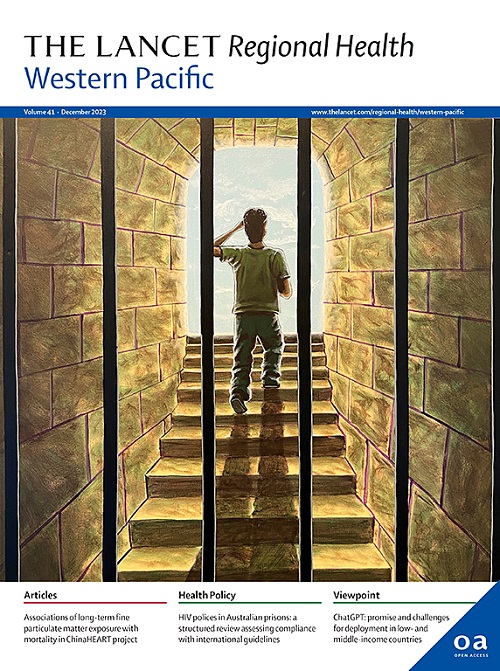Burden of cirrhosis and other chronic liver diseases and their progression to hepatocellular carcinoma in East Asia Pacific: 1990 to 2021
IF 7.6
1区 医学
Q1 HEALTH CARE SCIENCES & SERVICES
引用次数: 0
Abstract
Background
Cirrhosis and other chronic liver diseases (CLD), along with liver cancer, present significant health challenges in the East Asia Pacific (EAP) region. This study evaluates the burden of CLD and its progression to hepatocellular carcinoma (HCC) from 1990 to 2021.
Methods
Data from the Global Burden of Disease Study 2021 were analyzed to examine trends in CLD burden and annual transition rates to HCC across different etiologies and sociodemographic index (SDI) regions. The estimated annual percentage change (EAPC) was used to assess trends in age-standardized rates (ASR). Correlations between age-standardized DALY rates (ASDR), annual transition rates, and SDI were determined using Spearman’s rank correlation. Risk factors, such as high alcohol and drug use, were also evaluated.
Findings
The prevalence of CLD in EAP increased significantly by 43.80% (95% UI: 38.23% to 48.77%) from 1990 to 2021, while the ASDR decreased (EAPC: -2.42% [95% CI: -2.48% to -2.36%]), notably in high and high-middle SDI regions. HBV and HCV remained the leading causes of CLD across all SDI regions, with alcohol use and NAFLD increasingly contributing, particularly in high SDI regions. A significant negative correlation was observed between ASDR and SDI in high (ρ=-0.20, p<0.01), middle (ρ=-0.49, p<0.001), and low-middle (ρ=-0.63, p<0.001) SDI regions. Despite this, high alcohol use and drug use contributed more to DALYs across all SDI regions, and the annual transition rate to HCC was rising (1.09% [0.89% to 1.28%]), with the highest rates in high SDI regions. The transition rate from CLD to HCC is rising in EAP, much exceeding the global rate. High SDI regions showed higher transition rates, particularly among those with chronic hepatitis B, C, and NAFLD including cirrhosis. A significant positive relationship was found between the transition rate from CLD to HCC and SDI in high (ρ=0.60, p<0.001) and low-middle (ρ=0.34, p<0.001) SDI regions.
Interpretation
While the EAP region has made progress in reducing the burden of CLD, greater attention is needed for alcohol use and NAFLD. The progression from CLD to HCC warrants increased focus, especially in high SDI regions. Enhanced surveillance for HCC in patients with chronic hepatitis is crucial.
东亚太平洋地区肝硬化和其他慢性肝病的负担及其向肝细胞癌的进展:1990年至2021年
肝硬化和其他慢性肝病(CLD)以及肝癌是东亚太平洋地区(EAP)面临的重大健康挑战。本研究评估了1990年至2021年CLD的负担及其向肝细胞癌(HCC)的进展。方法分析来自2021年全球疾病负担研究的数据,以检查不同病因和社会人口指数(SDI)区域的CLD负担趋势和向HCC的年转化率。估计的年百分比变化(EAPC)用于评估年龄标准化率(ASR)的趋势。年龄标准化DALY率(ASDR)、年转换率和SDI之间的相关性采用Spearman等级相关来确定。还对酗酒和吸毒等风险因素进行了评估。从1990年到2021年,EAP的CLD患病率显著增加了43.80% (95% UI: 38.23%至48.77%),而ASDR下降(EAPC: -2.42% [95% CI: -2.48%至-2.36%]),特别是在高和中高SDI地区。HBV和HCV仍然是所有SDI地区CLD的主要原因,酒精使用和NAFLD的作用越来越大,特别是在高SDI地区。在SDI高(ρ=-0.20, p<0.01)、中(ρ=-0.49, p<0.001)和中低(ρ=-0.63, p<0.001)区域,ASDR与SDI之间存在显著的负相关。尽管如此,在所有SDI地区,高度酒精使用和药物使用对DALYs的贡献更大,并且向HCC的年转化率正在上升(1.09%[0.89%至1.28%]),其中高SDI地区的转化率最高。在EAP中,从CLD到HCC的转变率正在上升,远远超过全球水平。高SDI地区显示出更高的转归率,特别是在慢性乙型肝炎、丙型肝炎和NAFLD(包括肝硬化)患者中。在SDI高(ρ=0.60, p<0.001)和中低(ρ=0.34, p<0.001)区域,从CLD到HCC的转变率与SDI呈显著正相关。虽然东亚地区在减轻慢性肝病负担方面取得了进展,但需要更多地关注酒精使用和NAFLD。从CLD到HCC的进展值得更多关注,特别是在高SDI地区。加强对慢性肝炎患者HCC的监测至关重要。
本文章由计算机程序翻译,如有差异,请以英文原文为准。
求助全文
约1分钟内获得全文
求助全文
来源期刊

The Lancet Regional Health: Western Pacific
Medicine-Pediatrics, Perinatology and Child Health
CiteScore
8.80
自引率
2.80%
发文量
305
审稿时长
11 weeks
期刊介绍:
The Lancet Regional Health – Western Pacific, a gold open access journal, is an integral part of The Lancet's global initiative advocating for healthcare quality and access worldwide. It aims to advance clinical practice and health policy in the Western Pacific region, contributing to enhanced health outcomes. The journal publishes high-quality original research shedding light on clinical practice and health policy in the region. It also includes reviews, commentaries, and opinion pieces covering diverse regional health topics, such as infectious diseases, non-communicable diseases, child and adolescent health, maternal and reproductive health, aging health, mental health, the health workforce and systems, and health policy.
 求助内容:
求助内容: 应助结果提醒方式:
应助结果提醒方式:


